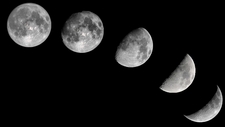Moon Phases

TEKS Objective
The student is expected to observe and record changes in the appearance of objects in the sky such as clouds, the Moon, and stars, including the Sun.
Essential Understanding
The student knows that the natural world includes the air around us and objects in the sky.
Science Background
Moon Phases: Stardate (website) - Monthly calendar of moon phases.
Moon Phases
The University of Texas McDonald Observatory, Stardate, stardate.org
Earth’s Moon: NASA (website) - The moon is Earth’s only natural satellite. It influences Earth’s cycles, including tides. Learn more about our moon at the link below.
Earth’s Moon
NASA, www.nasa.gov
Understanding the Moon Phases: MoonConnection.com (website) - A detailed illustration of Earth and the moon, along with accompanying text, helps students understand the phases of the moon.
Signature Lesson
Moon Glow: NASA, Starchild (website) - Investigate the relationship between the Earth and moon, the phases of the moon, and the alignment of Earth, Sun and moon that produces solar and lunar eclipses.
- Supporting Lessons
- Extensions
- Assessment Ideas
- Literature Connections
- Related
TEKS - Additional Resources
Supporting Lessons
Observing the Moon: The University of Texas McDonald Observatory (PDF) - With binoculars and the naked eye, observe and record changes in appearance of the moon over time, and then compare these observations to images posted on the StarDate website (www.stardate.org).
Observing the Moon
The University of Texas McDonald Observatory, StarDate, www.stardate.org
Elaboration Lessons and Extensions
Moon Munchies: NASA, Engineering by Design (PDF) - Design is a creative problem-solving process. In this unit, students use the engineering design process to design and build a lunar plant growth chamber.
Assessment Ideas
Oreo Moon Phases: Learning Encounters (PDF) - Use Oreo cookies to represent the phases of the moon, as seen from Earth. Assess students’ understanding of the moon’s phases by using diagram B on page 4.
Literature Connections
Phases of the Moon. Olson, Gillia (ISBN 0736896171)
The Moon Book. Gibbons, Gail (ISBN 0823413640)
The Moon Seems to Change. Branley, Franklin (ISBN 0064450651)
Additional Resources
Observing the Moon: Harvard-Smithsonian Center for Astrophysics (website) - Students observe the moon over time and discuss its physical characteristics. (This unit is written for grades 2 - 6, but the first four activities may be modified for kindergarten and first grade.)
Observing the Moon
Harvard-Smithsonian Center for Astrophysics, hea-www.harvard.edu
Myths about Moon: Windows to the Universe (website) - Use stories, myths, rhymes, poetry, and games to teach students about the Moon.
Myths about Moon
Windows to the Universe, www.winsdows2universe.org
TEKS Navigation
Grade 1
Need Assistance?
If you need help or have a question please use the links below to help resolve your problem.

Comments